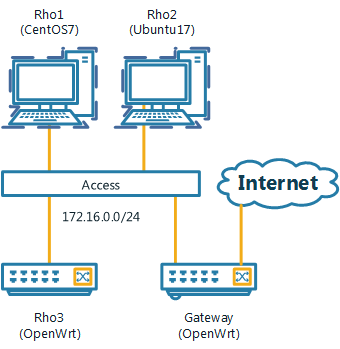Linux is a powerful operating system that is widely employed in server environments, as well as in embedded systems. This includes set-top boxes and the Android operating system, for example. It can also be used as a desktop environment and it supports similar functionality to Microsoft Windows.
Completing the activity, you will be able to compare graphical Linux applications with corresponding Windows applications.
Undertaking these activities students are required to maintain a lab book. Please see this post for more details: http://alexanderkist.com/keeping-a-lab-book/. All important steps and answers to the background research questions have to be logged. The documentation has to include enough information that another person can reproduce the results.
In this activity, you have access to a CentOS 7 Linux system (Rho1). It is connected to other nodes on the same network. However, for this exercise that is not important. The network topology is depicted below.

In the past, Linux installations were a tedious process, requiring detailed hardware understanding and advanced knowledge of Linux. Today, this process is as simple as installing software under Windows.
Linux comes in many flavours, called distributions. CentOS is used for this exercise. Main differences between the distributions include configuration, stability, release cycles, support cycles, ease of use and popularity. Ubuntu (www.ubuntu.com), for example, is another excellent distribution for general-purpose use. The popularity of distributions is changing over time. You can find a list of popular distributions here.
In this first activity, you will explore a graphical Linux interface. Linux provides software tools for almost any task. Standard office tools have been installed with CentOS. These are shown in the table below. Most of these applications are also available for Windows.
| Linux | Common Windows Tools | Available for Windows? | Online Alternatives |
| Firefox | Internet Explorer | Yes | Chrome |
| The GIMP | Photoshop | Yes | PIXLR |
| LibreOffice Writer | MS Word | Yes | Google Docs |
| LibreOffice Impress | MS PowerPoint | Yes | Google Slides |
| Thunderbird and Lightning | MS Outlook | Yes | Gmail |
Table 1: Linux Software and corresponding Windows Tools.
For each tool, open it, complete a few tasks and answer the following questions stating your personal opinion:
Firefox [1] is a web browser, widely used under Windows. You can access it by clicking on the blue/orange ball (earth with a re-fox) on the menu bar.
LibreOffice is an open-source, free opensource software suite that includes tools for many tasks, e.g. word processing, spreadsheets, presentations, graphics and databases. Write a short document and play with the options. Note that you can save MS Office compatible documents. Try also Impress and build a short presentation.
The GNU (General Public License) Image Manipulation Program (GIMP) is a free tool to retouch photos, compose and author images.
Thunderbird is mail and address book tool. Initially, you have to configure an email account. Evolution is an alternative email application.
There are a large number of free applications available that can assist with engineering problems. Many of these free applications are also available under MS Windows. Two examples include. GNUOctave and Scilab. Octave is a well-developed alternative to Matlab and it is installed on the test system.